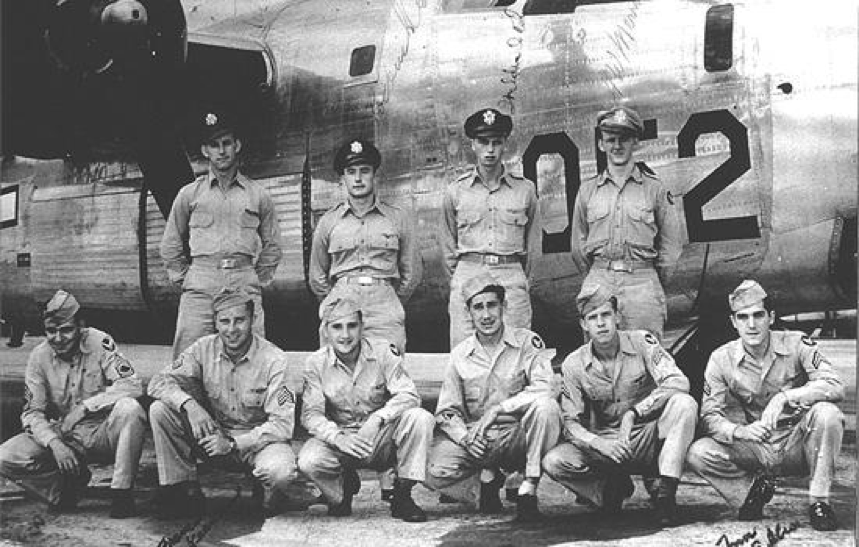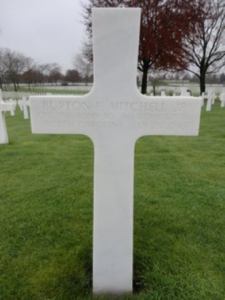Scroll of Honor – Burton Forrest Mitchell, Jr.
Unrewarded Valor
Everything at Clemson College changed in the spring of 1943. Of course  things had been changing for several months by then. The Japanese had attacked Pearl Harbor in December of ’41, then Hitler had declared war on the United States and Congress had returned the sentiment. A lot of cadets left school to join up, most with the Army, but a number in the Navy and Marines as well. By the spring of 1943, the War Department had decreed that graduating seniors would immediately enter service—and so would the rising juniors, who would forego their final year of college.
things had been changing for several months by then. The Japanese had attacked Pearl Harbor in December of ’41, then Hitler had declared war on the United States and Congress had returned the sentiment. A lot of cadets left school to join up, most with the Army, but a number in the Navy and Marines as well. By the spring of 1943, the War Department had decreed that graduating seniors would immediately enter service—and so would the rising juniors, who would forego their final year of college.
Perhaps Burton Forrest Mitchell, Jr. a member of the Class of 1946 from Mount Holly, North Carolina, decided to exercise what little control over his fate that he still possessed. Mitchell, who had just completed his freshman year on campus, reported for active duty at Fort Jackson on September 2, 1943. Following his basic training, Mitchell was assigned to the Army Air Forces and sent to Tyndall Air Field in Florida for aerial gunnery training. He underwent additional training at Westover, Massachusetts and Savannah, Georgia before shipping overseas in October 1944.
Mitchell eventually landed in the 766th Bomber Squadron, Heavy, headquartered at Torretta Air Base outside of Foggia, Italy as part of the 15th Air Force. The 15th flew missions against targets in Austria, Bavaria and the Balkans.
On January 20, 1945, Mitchell’s aircraft, a B-24J Liberator  heavy bomber piloted by Second Lieutenant Joseph O’Neal of Beckley, West Virginia, was alerted for a bombing mission against the railroad marshaling yards at Linz, Austria, about 460 miles to the north. As the rear turret gunner, Corporal Mitchell’s “desk” looked out from the rear of the aircraft. Sitting in the tail of the aircraft, Mitchell was the farthest crew member from the flight deck from where the pilot and copilot flew the plane.
heavy bomber piloted by Second Lieutenant Joseph O’Neal of Beckley, West Virginia, was alerted for a bombing mission against the railroad marshaling yards at Linz, Austria, about 460 miles to the north. As the rear turret gunner, Corporal Mitchell’s “desk” looked out from the rear of the aircraft. Sitting in the tail of the aircraft, Mitchell was the farthest crew member from the flight deck from where the pilot and copilot flew the plane.
The weather aloft that morning was clear and cold at 23,000 feet. Mitchell and his crewmates were wearing insulated, heated flight suits, boots, gloves, leather helmets and goggles to protect themselves in the unpressurized aircraft. They were also breathing oxygen from the aircraft’s O2 tanks as the air at that altitude was too thin to support life.
The twenty-five bomber formation flew over the jagged peaks of the Alps and then homed in on Linz. The North Main Marshalling Yard to the south of the city was covered with snow, but the anti-aircraft gunners defending the city were nonetheless alert. With lightly scattered clouds, the fire from the flak gunners was described as “extremely intense, accurate and heavy.”
Armed with 100 pound general purpose bombs, the mission of the attack was to destroy enemy rolling stock and facilities in the railroad yard, to further disable the enemy’s ability to move troops and equipment to counter the Red Army in the east and the British and Americans in the west. At approximately 1230 hours, Mitchell’s aircraft was struck in its open bomb bay by an anti-aircraft round. The subsequent explosion split the aircraft in two. The six men in the front portion of the aircraft never made it out.

The crew of Mitchell’s plane. Standing from left, pilot O’Neal, copilot Rothe, bombardier Koke, navigator Merritt—all of whom were killed. Kneeling from left, waist gunner Martin, waist gunner Keenan–who came to Mitchell’s assistance–nose gunner Rossini, ball gunner Nowosilski, Mitchell, and top gunner Ellis. Only Martin and Nowosilski survived.
The four gunners in the after half of the big bomber had a second chance. Even though they were now riding a piece of aerial wreckage falling through the sky, they were still alive. Right waist gunner Sergeant Donald Martin and ball gunner PFC Harry Nowosilski were able to don their parachutes and get clear of the fuselage. Left waist gunner Francis Keenan of Chicago, realized that Mitchell, alone in the tail, had been badly burned in the explosion and he went to his crewmate’s aid. He helped Mitchell clip on his parachute, which was too bulky to wear at his gunner’s position. As the two men struggled to exit the chaos and confusion of the falling wreck, Mitchell is believed to have accidentally pulled his parachute’s ripcord. As a result, his chute and Keenan’s became entangled and failed to deploy. Keenan’s valor cost him his life.
The bodies of Mitchell, Keenan and the six men from the front half of the plane were recovered and buried by the Germans. Martin and Nowosilski were captured and spent the final months of the conflict in Luftwaffe prisoner of war camps.
Twenty-one of the twenty-five aircraft over the target that day were damaged  by anti-aircraft fire. Two of these, including Mitchell’s, exploded before they could roll out of the formation on the bomb run. Their explosions caused the other planes in the formation to take evasive action to avoid colliding with the fatally wounded aircraft. As a result, the bombs were scattered over a comparatively large area at the extreme northern end of the marshalling yard.
by anti-aircraft fire. Two of these, including Mitchell’s, exploded before they could roll out of the formation on the bomb run. Their explosions caused the other planes in the formation to take evasive action to avoid colliding with the fatally wounded aircraft. As a result, the bombs were scattered over a comparatively large area at the extreme northern end of the marshalling yard.
Mitchell was awarded the Air Medal and Purple Heart. He was survived by his parents and sister. After the war, his body was removed to the Lorraine American Cemetery in St. Avold (Moselle), France.
For additional information on Corporal Burton Forrest Mitchell, Jr. see:
https://soh.alumni.clemson.edu/scroll/burton-forrest-mitchell-jr/
For more information about Clemson University’s Scroll of Honor visit:
https://soh.alumni.clemson.edu/
